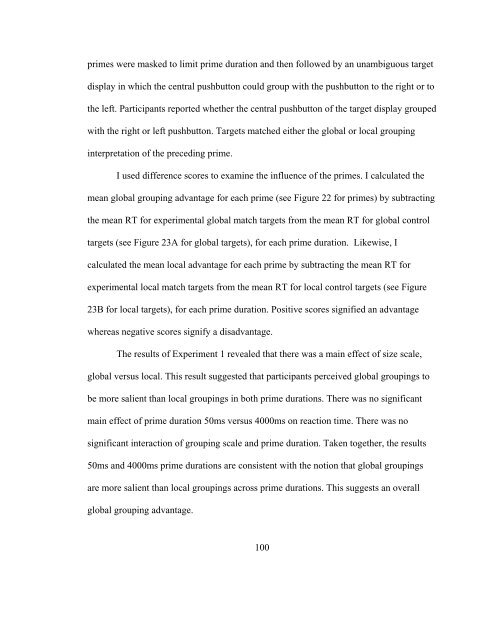The Use of Iambic Pentameter in the
The Use of Iambic Pentameter in the
The Use of Iambic Pentameter in the
Create successful ePaper yourself
Turn your PDF publications into a flip-book with our unique Google optimized e-Paper software.
primes were masked to limit prime duration and <strong>the</strong>n followed by an unambiguous target<br />
display <strong>in</strong> which <strong>the</strong> central pushbutton could group with <strong>the</strong> pushbutton to <strong>the</strong> right or to<br />
<strong>the</strong> left. Participants reported whe<strong>the</strong>r <strong>the</strong> central pushbutton <strong>of</strong> <strong>the</strong> target display grouped<br />
with <strong>the</strong> right or left pushbutton. Targets matched ei<strong>the</strong>r <strong>the</strong> global or local group<strong>in</strong>g<br />
<strong>in</strong>terpretation <strong>of</strong> <strong>the</strong> preced<strong>in</strong>g prime.<br />
I used difference scores to exam<strong>in</strong>e <strong>the</strong> <strong>in</strong>fluence <strong>of</strong> <strong>the</strong> primes. I calculated <strong>the</strong><br />
mean global group<strong>in</strong>g advantage for each prime (see Figure 22 for primes) by subtract<strong>in</strong>g<br />
<strong>the</strong> mean RT for experimental global match targets from <strong>the</strong> mean RT for global control<br />
targets (see Figure 23A for global targets), for each prime duration. Likewise, I<br />
calculated <strong>the</strong> mean local advantage for each prime by subtract<strong>in</strong>g <strong>the</strong> mean RT for<br />
experimental local match targets from <strong>the</strong> mean RT for local control targets (see Figure<br />
23B for local targets), for each prime duration. Positive scores signified an advantage<br />
whereas negative scores signify a disadvantage.<br />
<strong>The</strong> results <strong>of</strong> Experiment 1 revealed that <strong>the</strong>re was a ma<strong>in</strong> effect <strong>of</strong> size scale,<br />
global versus local. This result suggested that participants perceived global group<strong>in</strong>gs to<br />
be more salient than local group<strong>in</strong>gs <strong>in</strong> both prime durations. <strong>The</strong>re was no significant<br />
ma<strong>in</strong> effect <strong>of</strong> prime duration 50ms versus 4000ms on reaction time. <strong>The</strong>re was no<br />
significant <strong>in</strong>teraction <strong>of</strong> group<strong>in</strong>g scale and prime duration. Taken toge<strong>the</strong>r, <strong>the</strong> results<br />
50ms and 4000ms prime durations are consistent with <strong>the</strong> notion that global group<strong>in</strong>gs<br />
are more salient than local group<strong>in</strong>gs across prime durations. This suggests an overall<br />
global group<strong>in</strong>g advantage.<br />
100

















